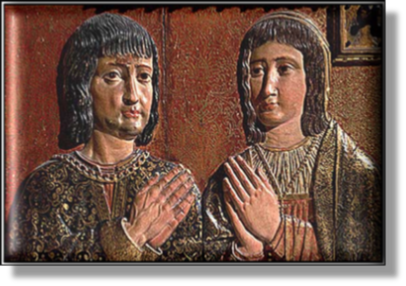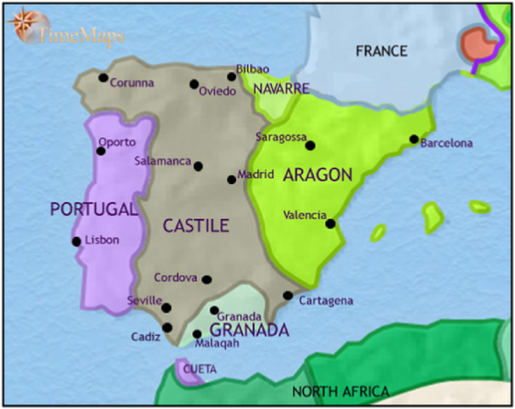


Including:
Ferdinand of Aragon
and
Isabella of Castile

SPAIN -
xxxxxWith the capture of Cordoba by Ferdinand III in 1236 (H3), followed by the taking of Seville in 1248, only a small area in and around Grenada remained in Arab hands. As we have seen, in 1340 (E3) the Muslims did try to retake the peninsula, but they were soundly beaten and forced to return to North Africa. By this time Spain was made up of two large kingdoms, and with the marriage of their leaders, Ferdinand of Aragon and Isabella of Castile, in 1469, the unity of the country was in the making. At this time, however, both kept their crowns as "Catholic Monarchs". Nonetheless, they were united in their aim to rid Spain of any Arab occupation. As we shall see, this was accomplished in 1492 (H7) with the capture of Grenada and its fortified palace of Alhambra.
xxxxxIt was the Battle of Las Navas de  Tolosa in 1212 (JO) which marked the beginning of the end for Almohad rule in the Iberian peninsula. With the coming to power of Ferdinand III, determined to push the Moors out of Spain, their fate was sealed. In 1236 (H3) he captured the town of Cordoba, and after this one city after another fell to the Christian forces, strengthened by a large number of crusaders. When Seville was taken in 1248, only a small area in the south-
Tolosa in 1212 (JO) which marked the beginning of the end for Almohad rule in the Iberian peninsula. With the coming to power of Ferdinand III, determined to push the Moors out of Spain, their fate was sealed. In 1236 (H3) he captured the town of Cordoba, and after this one city after another fell to the Christian forces, strengthened by a large number of crusaders. When Seville was taken in 1248, only a small area in the south-
xxxxxBy  this time Christian Spain consisted of two great kingdoms. In the west was the Kingdom of Castile and Léon, with such centres as Asturias, Cordoba and Seville, and in the east was the Kingdom of Aragon, including Barcelona, Valencia and the Balearic Islands. In 1469, with the marriage of the leaders of these two powerful kingdoms, Ferdinand of Aragon (1452-
this time Christian Spain consisted of two great kingdoms. In the west was the Kingdom of Castile and Léon, with such centres as Asturias, Cordoba and Seville, and in the east was the Kingdom of Aragon, including Barcelona, Valencia and the Balearic Islands. In 1469, with the marriage of the leaders of these two powerful kingdoms, Ferdinand of Aragon (1452-
xxxxxBut there was certainly agreement between the two kingdoms on one question: the need to complete the La Reconquista (The Reconquest). As we shall see, this was accomplished in 1492 (H7) with the capture of Granada and its fortified palace of Alhambra, the last Muslim stronghold in Spain.



Acknowledgements
Ferdinand and Isabella: wood relief by the Spanish sculptor Alonso de Mena (1587-
E4-